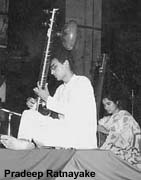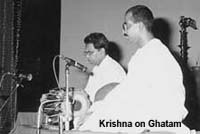
Pradeepanjali: so absorbing
An absorbing evening it was. A highly appreciative
crowd had gathered at the Lionel Wendt theatre to see and hear Pradeep
Ratnayake present his latest creations on the sitar.
Having started the concert presenting a few classical pieces, Pradeep
moved over to a fusion of  eastern
and western music. With Lakshman Joseph de Saram on the violin and Wijeratne
Ranatunga on the tabla, he presented a piece titled Flight. Lalanath
de SIlva on the flute and Pradeep on the sitar were a superb combination
in 'Remembering yesterday'. His interpretation of the Gajaga Vannama
accompanied by Piyasara Shilpadhipathi playing the Kandyan drum, Udekki
and the Tammattama, with violins, cello and double bass supporting, aroused
a lot of interest. And the final item'Wind' brought a superb foursome
to the fore - Pradeep, Wijeratne Ranatunga (tabla),Ravibandu Vidyapathi
(Pakwaj) and Krishna (ghatam). eastern
and western music. With Lakshman Joseph de Saram on the violin and Wijeratne
Ranatunga on the tabla, he presented a piece titled Flight. Lalanath
de SIlva on the flute and Pradeep on the sitar were a superb combination
in 'Remembering yesterday'. His interpretation of the Gajaga Vannama
accompanied by Piyasara Shilpadhipathi playing the Kandyan drum, Udekki
and the Tammattama, with violins, cello and double bass supporting, aroused
a lot of interest. And the final item'Wind' brought a superb foursome
to the fore - Pradeep, Wijeratne Ranatunga (tabla),Ravibandu Vidyapathi
(Pakwaj) and Krishna (ghatam).
I wished the performance was better co-ordinated. Fewer introductions,
particularly tracing Pradeep's early days(everyone acknowledges his talent)
would have helped to create a greater impact.
The 'thank you' speech at the end was uncalled for. It certainly took
away from the climax Pradeepanjali reached. Let's hope it will be
a more professional presentation next time.The Ghatam  Man
Krishna, the ghatam man at Pradeepanjali was a treat. From the moment
he came on stage carrying his 'Kalagediya" and sat down, the audience
was with him. Whether he was playing the Ghatam or not, he was very much
part of Pradeep, so to say. He appreciated every bit of what Pradeep played
. His total participation made the evening an extremely lively one. Man
Krishna, the ghatam man at Pradeepanjali was a treat. From the moment
he came on stage carrying his 'Kalagediya" and sat down, the audience
was with him. Whether he was playing the Ghatam or not, he was very much
part of Pradeep, so to say. He appreciated every bit of what Pradeep played
. His total participation made the evening an extremely lively one.
"He seems to be feeling the heat", someone quipped when he
pulled out his shawl and played bare bodied in traditional style.
He had good company in Ravibandu , the versatile drummer who is very
much at home whether it be the 'geta bera', Pakvaj or the Kohl.
All in all, Pradeepanjali was a fine team effort, which deserves
the support of promoters of the performing arts. Why look for outside talent
when we have so much of it among us? Lend them a hand and they sure will
not let you down
Innovative Musician
Musician Shelton Premaratne's quest for innovation
makes him stand out among so many. The best example of his capabilities
in doing something different came in Hunuwataye Kathawa when Henry
Jayasena picked on him to create the music.
That was three decades ago.
"Every day (for rehearsals) Shelton Premaratne used to bring new
types of musical instruments. Some  of
these had been improvised from odd gadgets, particularly those used to
indicate wind and rain. He created the sound of wind through a smart instrument
turned out from a brass ball found in a door lock". So says Henry
in Nimnethi Kathawak 2 describing Shelton's contribution to Hunuwataya. of
these had been improvised from odd gadgets, particularly those used to
indicate wind and rain. He created the sound of wind through a smart instrument
turned out from a brass ball found in a door lock". So says Henry
in Nimnethi Kathawak 2 describing Shelton's contribution to Hunuwataya.
He continued to experiment. In Sathischandra Edirisinghe's Hotabari
Yudde ( a story involving animals), he depicted the characteristics
of different animals through music.
And then came Dundu Bere, his own production, and the story of
a drum. He used sounds obtained through many a discarded item to create
music which normal instruments couldn't provide.
Recognition for his contribution towards innovative music came last
week, though belated, in the form of a State Award at the State Music Festival
organized by the Department of Cultural Affairs.
Shelton was among 13 veteran musicians who were honoured for their contribution
in different aspects of music..
Among the pioneers
Sri Lanka (then Ceylon) was one of the earliest
countries in the world to initiate broadcasting at a national level after
the British Broadcasting Company (not to be confused with the British Broadcasting
Corporation) started operations on 15 November 1922. The efforts of an
enthusiastic band of men who formed the Ceylon Wireless Society made this
possible. Who were they?
The President was the then Director of Education, L. Marcie. The secretary
was the indefatigable Marcus Rockwood, father of the fomer DIG Gabriel
Rockwood (Father of Police Radio).
Among the others were Justice R.F. Dias, father of former Minister Felix
R. Dias Bandaranaike, M. M. P.Gunawardene, father of media specialist Victor
Gunawardene, Chief Engineer of CTO Edward Harper, his deputy John Stilitoe,
A. Nadarasa, W. E. de Silva, H. B. F. de Silva and A. W. Dharmapala.
As a first step, a 250 watt transmitter was built using parts taken
off the radio equipment of a German submarine captured in World War I (1914-1918)
and the ship- to-shore spare parts in the Telegraph Stores. Starting off
as a mid-day and evening service on Thursdays & Fridays, it was extended
to cover the whole day on 16 December 1925 when the Governor, Sir Hugh
Clifford inaugurated the regular service. Incidentally, it coincides with
the day Arthur C. Clarke was born. It also happened to be the day when
48-RPM discs were released to the international music world.
These details appear in 'Nidahasai Guwan Viduliyai' released by the
SLBC to mark the Golden Jubilee of Independence, in a chapter written by
'a former broadcaster'.
|



